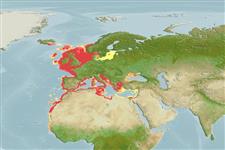Common names from other countries
Elasmobranchii (haaien en roggen) (sharks and rays) >
Carcharhiniformes (Ground sharks) >
Scyliorhinidae (Cat sharks) > Scyliorhininae
Etymology: Scyliorhinus: skylion, Greek for dogfish or small shark; rhinus, from rhine (Gr.), rasp, alluding to a shark’s jagged, rasp-like skin. (See ETYFish); stellaris: Latin for starry or of the stars, referring to many large and small black and white spots on body. (See ETYFish).
More on author: Linnaeus.
Environment: milieu / climate zone / depth range / distribution range
Ecologie
marien rifbewoner; diepte 1 - 400 m (Ref. 27000), usually 20 - 63 m (Ref. 244). Subtropical; 63°N - 12°N, 19°W - 37°E
Northeast Atlantic: southern Scandinavia to Mediterranean, Morocco, Mauritania to Senegal (Ref. 125614). Records further south in the Atlantic, to Gulf of Guinea and Congo River mouth may be misidentifications of Scyliorhinus cervigoni (Ref. 127434).
Lengte bij maturiteit / Grootte / Gewicht / Leeftijd
Maturity: Lm 78.0, range 77 - 79 cm
Max length : 170 cm TL mannelijk / geslacht onbekend; (Ref. 26999); common length : 125 cm TL mannelijk / geslacht onbekend; (Ref. 244); max. gerapporteerde leeftijd: 19 Jaren (Ref. 72467)
Dorsale stekels (totaal): 0; Dorsale zachte stralen (totaal): 0; Anale stekels 0; Anale zachte stralen: 0. A large, fairly stocky, catshark with large and small black spots and sometimes white spots covering dorsal surface, saddle markings obsolete, small anterior nasal flaps that do not reach the mouth, no nasoral grooves, labial furrows on lower jaw only, second dorsal fin much smaller than first (Ref. 244)
A common inshore and offshore shark found on the continental shelf over rough, even rocky or coralline ground, and algal-covered bottoms. Found at depths of 1 or 2 m to at least 125 m. Feed on bottom-living invertebrates such as mollusks and crustaceans and on demersal fishes (e.g. sharks, S. canicula). Oviparous (Ref. 50449). Utilized fresh and dried salted for human consumption, and processed into fishmeal. May attain 170 cm (Ref. 27000).
Oviparous, with a single egg per oviduct (Ref. 244). Embryos feed solely on yolk (Ref. 50449). Size at hatching about 16 cm (Ref. 244).
Compagno, L.J.V., 1984. FAO Species Catalogue. Vol. 4. Sharks of the world. An annotated and illustrated catalogue of shark species known to date. Part 2 - Carcharhiniformes. FAO Fish. Synop. 125(4/2):251-655. Rome: FAO. (Ref. 244)
Status op de Rode Lijst van het IUCN (Ref. 130435)
CITES (Ref. 128078)
Not Evaluated
Gevaar voor de mens
Harmless
Gebruik door de mens
Visserij: van minder commercieel belang; Aquarium: Publieke aquaria
Meer informatie
ReferentiesAquacultuurAquacultuurprofielKweeklijnenGeneticaElectrophoresesErfelijkheidZiektesVerwerkingMassaconversie
Tools
Speciale rapporten
Download XML
Internetbronnen
Estimates based on models
Preferred temperature (Ref.
115969): 7.8 - 19.5, mean 10.9 (based on 836 cells).
Fylogenetische diversiteitsindex (Ref.
82804): PD
50 = 0.5000 [Uniqueness, from 0.5 = low to 2.0 = high].
Bayesian length-weight: a=0.00178 (0.00138 - 0.00230), b=3.19 (3.11 - 3.27), in cm Total Length, based on LWR estimates for this species (Ref.
93245).
Trofisch niveau (Ref.
69278): 4.0 ±0.3 se; based on diet studies.
Weerstandsvermogen (Ref.
120179): laag, minimale populatieverdubbelingstijd 4,5-14 jaar (Fec assumed to be <100).
Fishing Vulnerability (Ref.
59153): Very high vulnerability (90 of 100).
Climate Vulnerability (Ref.
125649): Moderate vulnerability (38 of 100).
